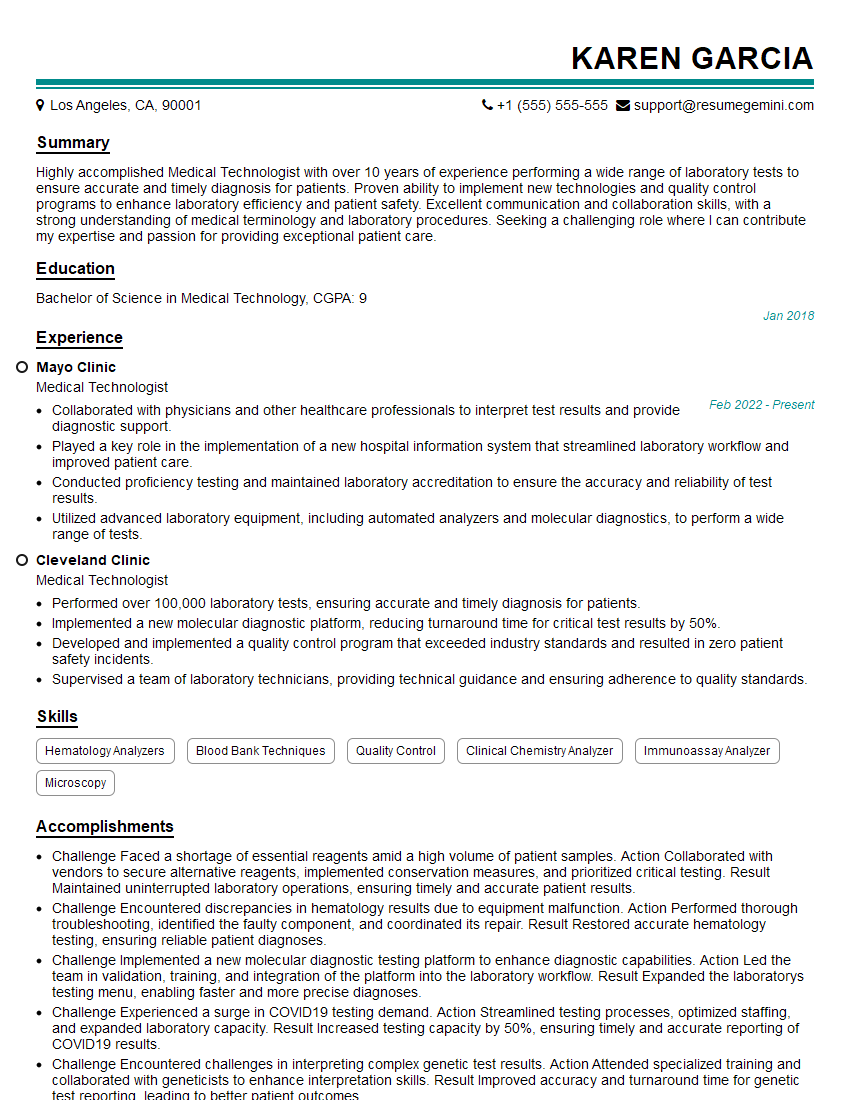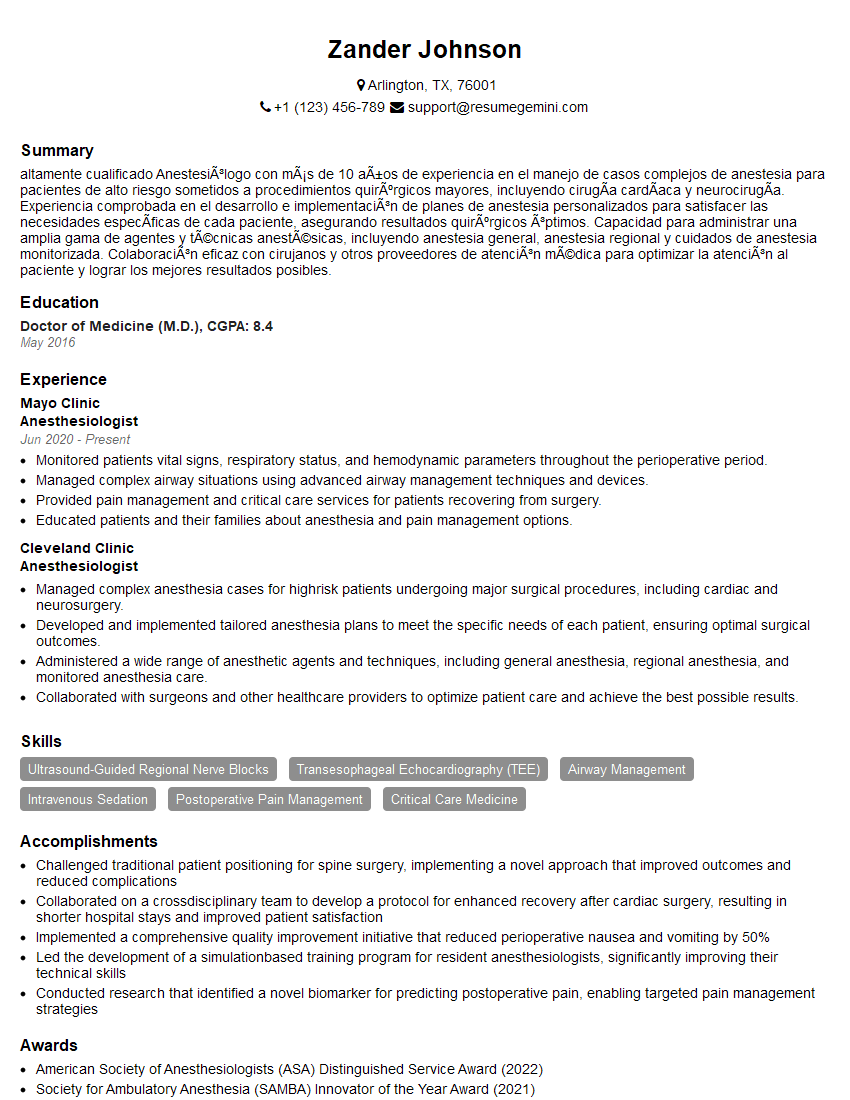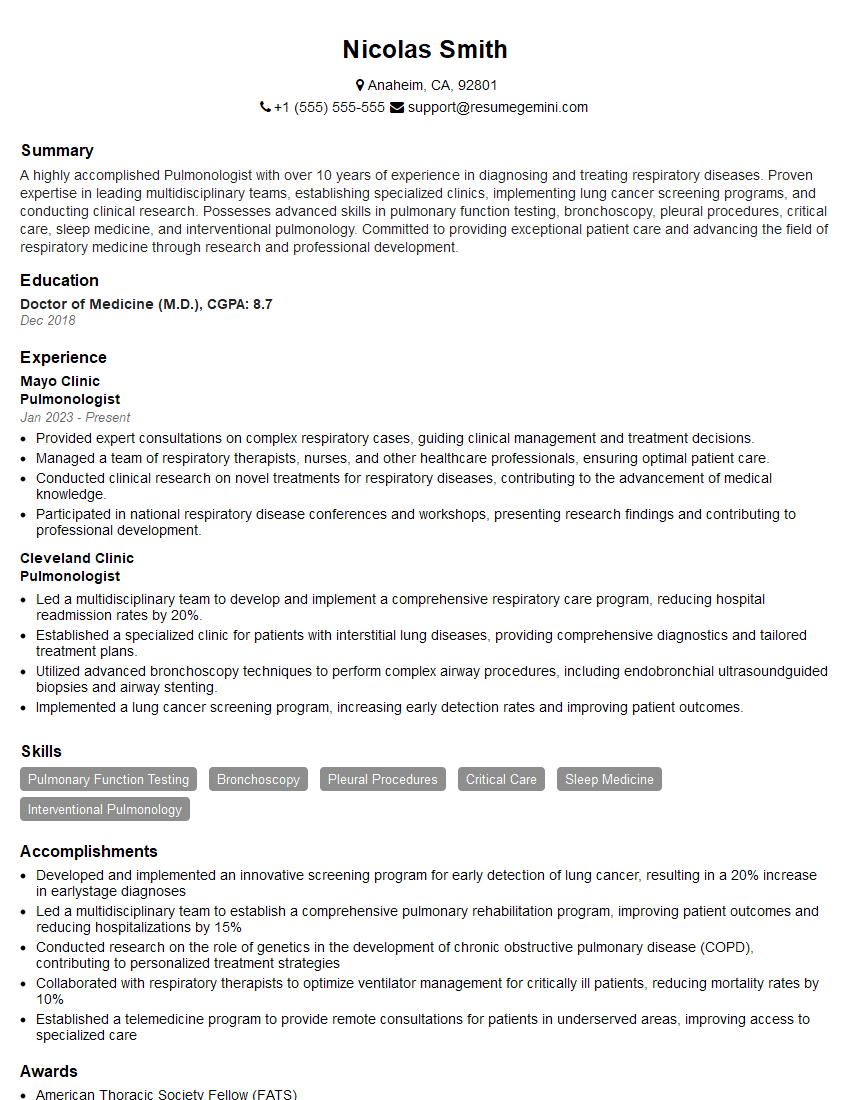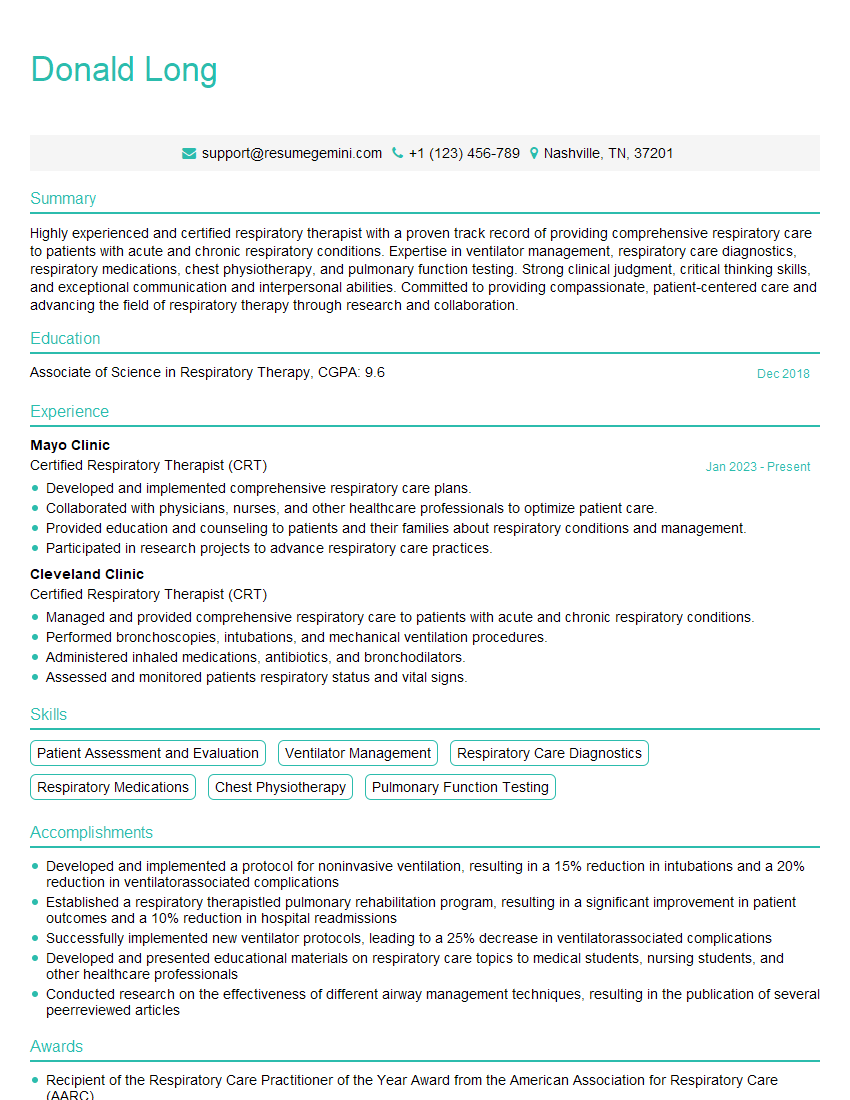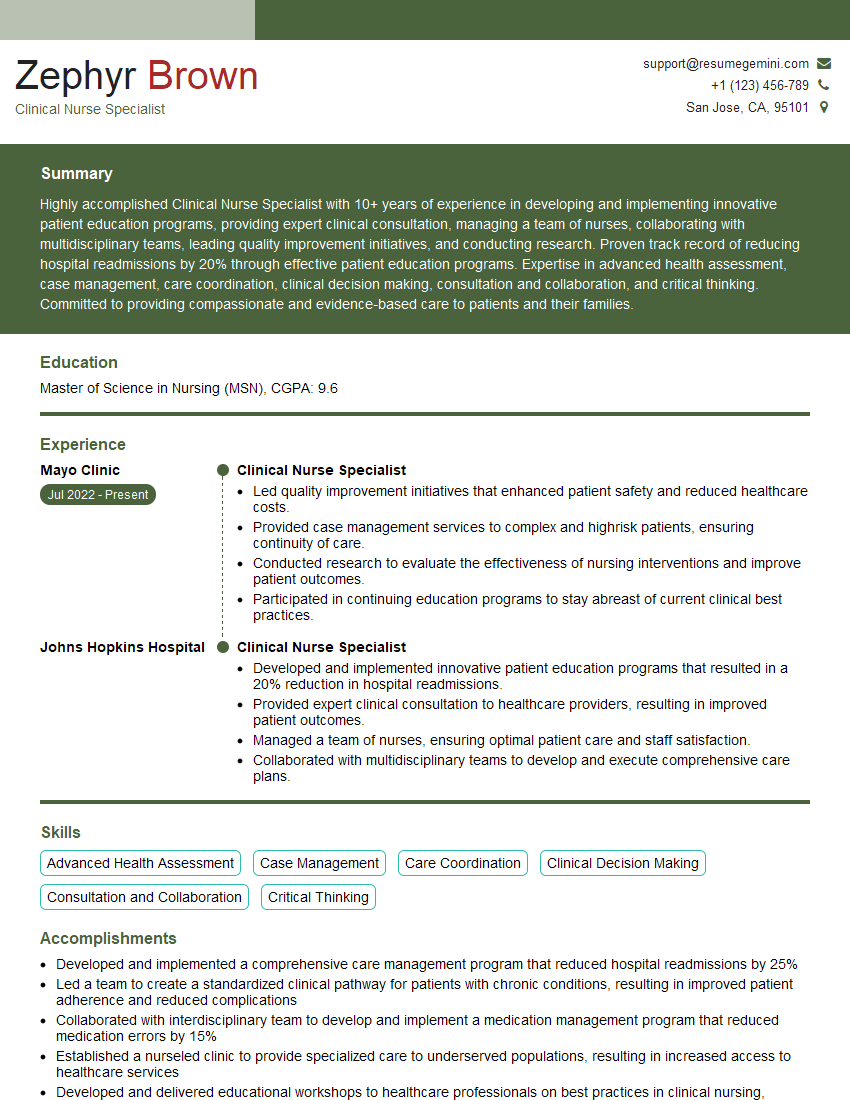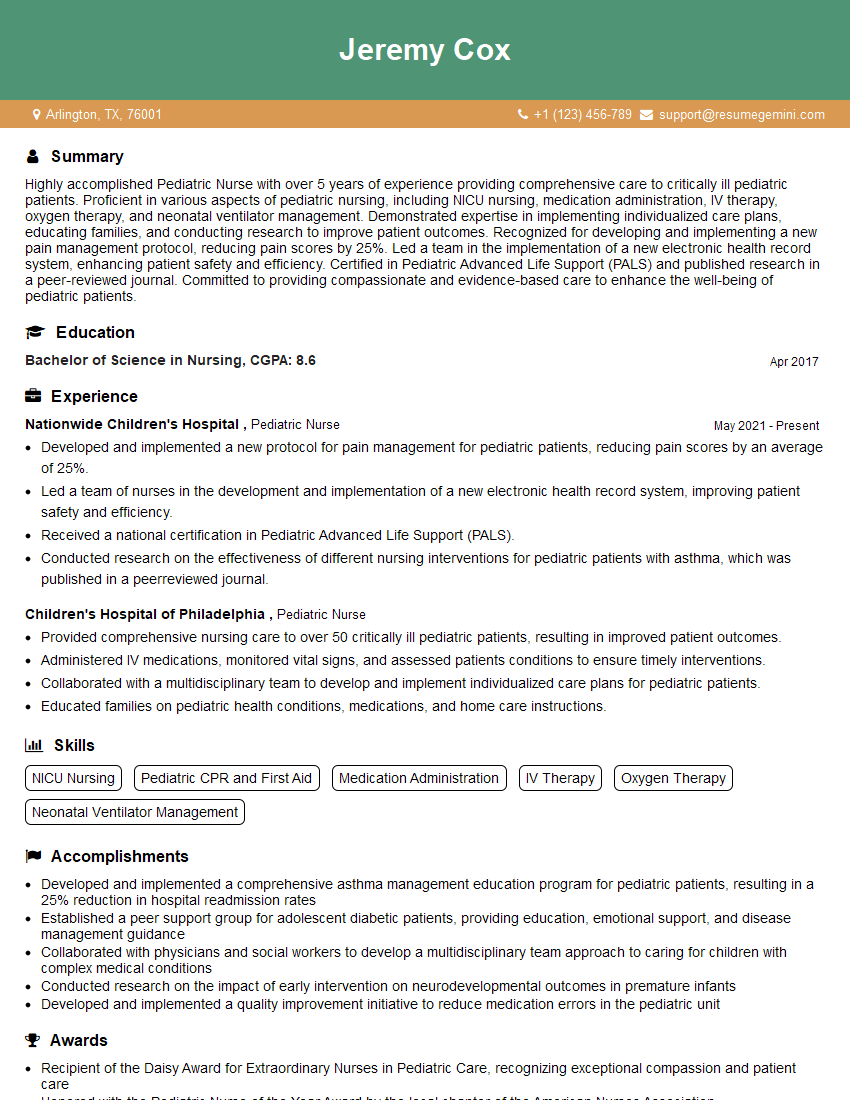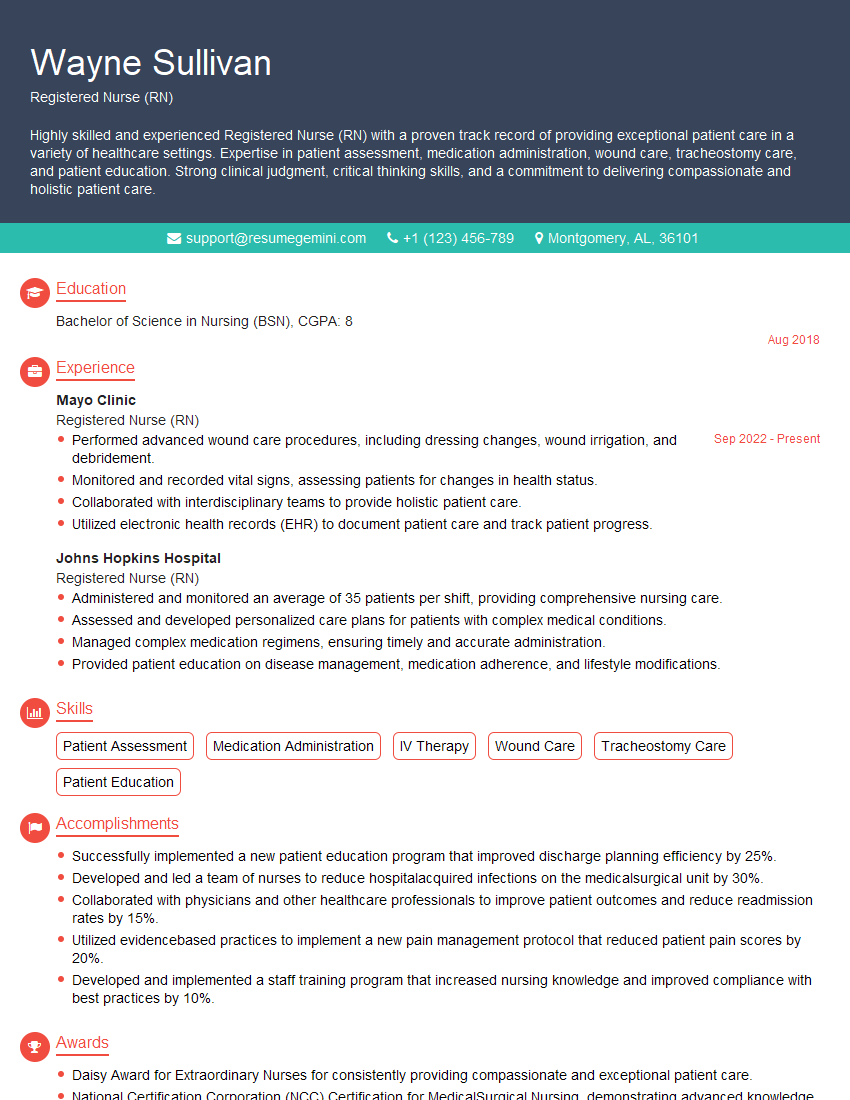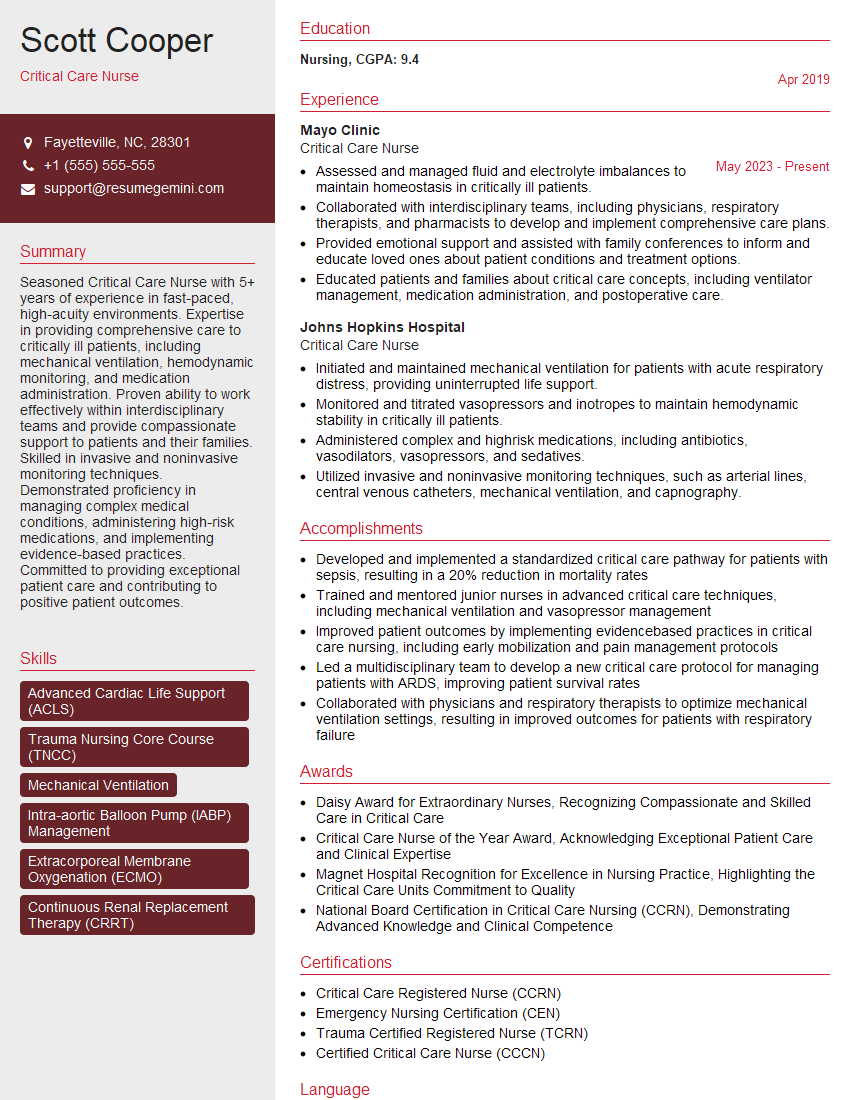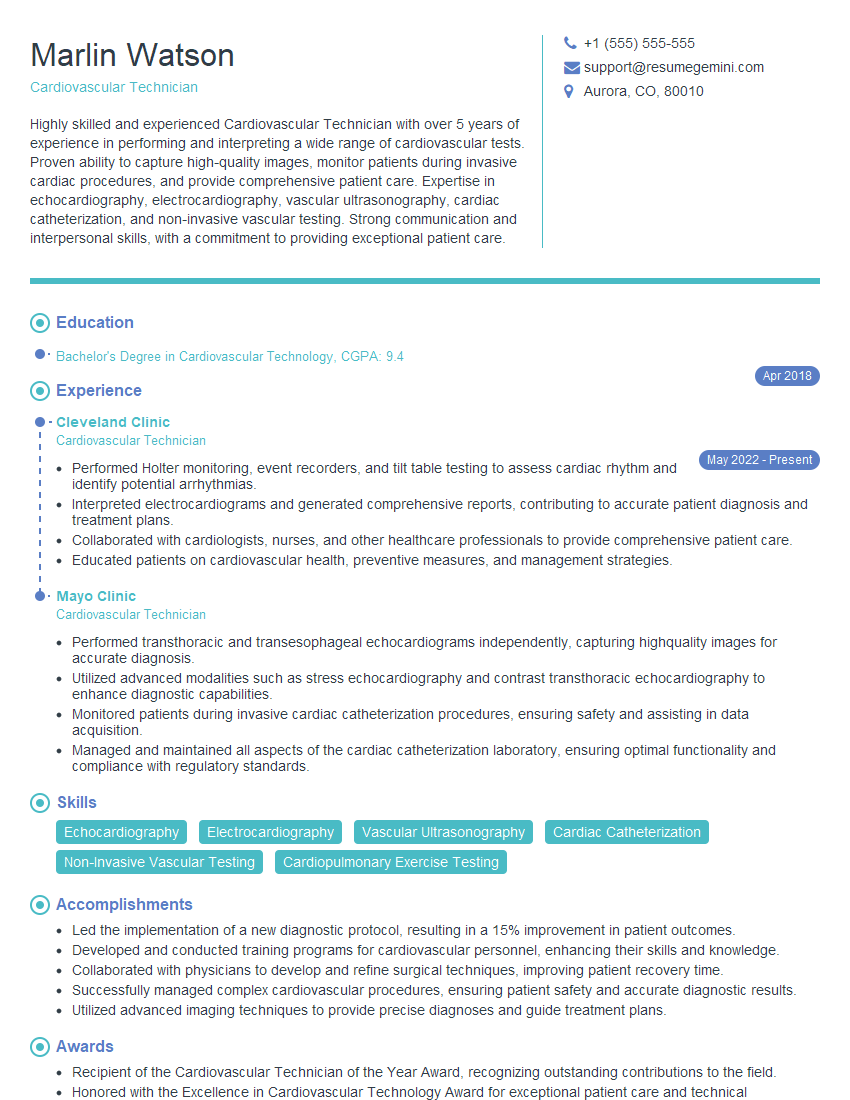Preparation is the key to success in any interview. In this post, we’ll explore crucial Oxygen Saturation Monitoring interview questions and equip you with strategies to craft impactful answers. Whether you’re a beginner or a pro, these tips will elevate your preparation.
Questions Asked in Oxygen Saturation Monitoring Interview
Q 1. Explain the principle of pulse oximetry.
Pulse oximetry is a non-invasive method for monitoring the oxygen saturation of arterial blood. It works by using a sensor, typically placed on a fingertip or earlobe, that emits two wavelengths of light – red and infrared – through the tissue. Hemoglobin, the protein in red blood cells that carries oxygen, absorbs these wavelengths differently depending on whether it’s carrying oxygen (oxyhemoglobin) or not (deoxyhemoglobin). The sensor measures the amount of light absorbed at each wavelength and uses this information to calculate the percentage of hemoglobin saturated with oxygen, known as SpO2.
Think of it like this: imagine shining a flashlight through a jar of red and blue marbles. If more red marbles are present, more red light will be absorbed. Similarly, oxyhemoglobin and deoxyhemoglobin absorb red and infrared light differently, allowing the pulse oximeter to differentiate between them and calculate the SpO2.
Q 2. What are the normal SpO2 ranges for adults and children?
Normal SpO2 ranges typically fall between 95-100% for both adults and children. Readings below 95% are generally considered hypoxemia (low blood oxygen) and warrant further investigation. However, it’s crucial to remember that normal ranges can vary slightly depending on factors like age, altitude, and underlying health conditions. For example, a healthy person living at high altitude might have a slightly lower ‘normal’ SpO2 than someone at sea level. Always interpret SpO2 readings within the context of the patient’s overall clinical picture.
Q 3. What factors can affect SpO2 readings?
Several factors can influence SpO2 readings, leading to inaccurate or misleading results. These include:
- Motion artifact: Movement of the sensor or patient can interfere with light transmission, resulting in inaccurate readings. This is especially common in restless patients or during transport.
- Poor perfusion: Inadequate blood flow to the measurement site (e.g., due to hypothermia, vasoconstriction, or low blood pressure) can lead to falsely low readings.
- Nail polish: Darkly colored nail polish can absorb light, causing inaccurate readings. It is important to remove nail polish from the fingertip or toe before applying the sensor.
- Jaundice: The presence of bilirubin in the blood can affect light absorption and potentially interfere with accurate measurement.
- Carbon monoxide poisoning: Carbon monoxide binds to hemoglobin, preventing oxygen binding. Pulse oximetry cannot differentiate between oxyhemoglobin and carboxyhemoglobin, potentially leading to falsely high readings despite actual hypoxemia.
- Anemia: While SpO2 measures saturation, not the absolute amount of oxygen, severe anemia can influence the reading because there are fewer red blood cells carrying oxygen.
- Ambient light: Excessive ambient light can interfere with the sensor’s light detection.
Q 4. Describe different types of pulse oximeters.
Pulse oximeters come in various forms, each suited for different applications:
- Handheld pulse oximeters: These are small, portable devices commonly used in clinical settings, during home healthcare, and in emergency situations. They provide a quick and convenient way to monitor SpO2 and pulse rate.
- Tabletop pulse oximeters: Larger, more sophisticated devices often used in hospitals and critical care units, these offer more advanced features and data logging capabilities.
- Multi-parameter monitors: These integrated devices measure SpO2 along with other vital signs like heart rate, blood pressure, and respiratory rate. They provide a comprehensive overview of the patient’s condition.
- Wrist-worn pulse oximeters: Designed for continuous, long-term monitoring, often used during sleep studies or for patients requiring ongoing oxygen saturation tracking.
The choice of oximeter depends heavily on the clinical context and the needs of the patient. For instance, a handheld device is ideal for quick assessments, whereas a continuous monitoring device might be necessary for a patient with respiratory instability.
Q 5. How do you interpret SpO2 readings in the context of other vital signs?
Interpreting SpO2 readings requires considering other vital signs. For example, a low SpO2 reading (e.g., below 90%) accompanied by a rapid heart rate, rapid breathing (tachypnea), and low blood pressure could indicate severe respiratory distress or shock. Conversely, a normal SpO2 with elevated heart rate and blood pressure could point towards anxiety or other cardiovascular issues.
A low SpO2 reading alone isn’t sufficient for diagnosis. It must be integrated with the clinical presentation, patient history, and other diagnostic findings to reach an accurate assessment. For example, a patient with a history of COPD might have a lower SpO2 baseline than a healthy individual, but it doesn’t necessarily indicate a serious problem unless accompanied by other symptoms of respiratory distress.
Q 6. What are the limitations of pulse oximetry?
While pulse oximetry is a valuable tool, it has limitations:
- It doesn’t directly measure arterial blood gases: It only provides an estimation of oxygen saturation; it does not provide information on arterial partial pressure of oxygen (PaO2) or carbon dioxide (PaCO2), which are crucial for a complete respiratory assessment.
- It can be affected by various factors: As discussed earlier, numerous factors can interfere with accurate readings, leading to misinterpretations.
- It may not detect all forms of hypoxemia: In situations like carbon monoxide poisoning, the reading may be deceptively normal despite severe oxygen deficiency.
- It doesn’t indicate the cause of hypoxemia: A low SpO2 reading simply indicates low oxygen saturation; it doesn’t pinpoint the underlying cause, which could range from respiratory failure to cardiac issues.
Therefore, pulse oximetry should be used as one component of a comprehensive assessment, not as the sole determinant of respiratory status.
Q 7. What are the potential causes of falsely low SpO2 readings?
Falsely low SpO2 readings can be caused by several factors, many of which are already discussed. The most common include:
- Poor perfusion: Hypothermia, vasoconstriction (e.g., due to cold temperatures or certain medications), or hypotension can reduce blood flow to the sensor, leading to inaccurate low readings.
- Motion artifact: Patient movement significantly affects light transmission and can drastically lower the reading.
- Nail polish or artificial nails: These can absorb light and prevent accurate readings.
- Severe anemia: Although SpO2 measures saturation, a critically low hemoglobin count might affect reading accuracy.
- Improper sensor placement: Incorrect positioning of the sensor can impact signal quality.
Addressing these issues, such as warming the patient, ensuring adequate perfusion, and properly applying the sensor, is crucial to obtaining accurate SpO2 readings. If a consistently low SpO2 is observed despite addressing these issues, further investigation is needed using other diagnostic tools such as arterial blood gas analysis.
Q 8. What are the potential causes of falsely high SpO2 readings?
Falsely high SpO2 readings, while less common than falsely low readings, can occur due to several factors. Essentially, the pulse oximeter is mistaking something other than oxygenated hemoglobin for oxygenated blood.
- Bright ambient light: Intense light sources, like sunlight or operating room lights, can interfere with the sensor’s ability to accurately measure light absorption, leading to inflated readings.
- Nail polish: Dark or opaque nail polish can block the light transmission, resulting in inaccurate SpO2 values. Even some clear polishes can interfere.
- Movement artifact: Patient movement, especially significant movement of the finger or probe, can disrupt the signal and cause falsely elevated readings. This is why proper probe placement and patient stabilization are crucial.
- Carbon monoxide poisoning: This is a serious concern because carbon monoxide (CO) binds to hemoglobin, preventing oxygen from binding. A pulse oximeter cannot distinguish between oxyhemoglobin (oxygen bound to hemoglobin) and carboxyhemoglobin (CO bound to hemoglobin), leading to a falsely elevated SpO2 reading despite the patient’s severe hypoxia.
- Certain dyes: Some dyes in clothing or medical equipment can interfere with light transmission.
- Peripheral vasoconstriction: In situations with poor perfusion (reduced blood flow), the signal may be weak, leading to inaccurate or intermittent readings. A falsely elevated reading can sometimes occur in this situation due to poor signal quality.
Therefore, it’s critical to always consider the clinical picture alongside the SpO2 reading and to address potential sources of interference.
Q 9. How do you troubleshoot a malfunctioning pulse oximeter?
Troubleshooting a malfunctioning pulse oximeter involves a systematic approach. First, we need to identify if the problem is with the device itself or with external factors.
- Check the probe and connection: Ensure the probe is securely attached to both the patient and the oximeter. Check for any damage to the probe or cable.
- Assess the patient: Verify proper placement of the probe (explained below) and check for factors like nail polish or excessive movement that could be causing inaccurate readings. Assess the patient’s overall clinical condition. Is their respiratory rate, heart rate, or skin color consistent with the oximeter reading?
- Check the device itself: Examine the oximeter’s display for error messages. Try a different probe if available. Check the oximeter’s battery level.
- Try a different site: If the readings are still questionable, try placing the probe on another finger or even an earlobe (although less common).
- Calibrate the device (if possible): Some pulse oximeters allow for calibration, which might be helpful in rectifying minor inconsistencies. However, only attempt this if you have the proper training and the device allows for user calibration.
- Replace the device: If all else fails, the pulse oximeter itself might be faulty and need replacement.
Remember to always document your troubleshooting steps and the resulting readings. If you’re unable to resolve the issue, seek assistance from a biomedical engineer or a supervisor.
Q 10. Describe the appropriate placement of a pulse oximeter probe.
Correct probe placement is paramount for accurate SpO2 readings. Ideally, the probe should be placed on a fingertip, avoiding the thumb. The sensor should be snug against the skin, ensuring adequate blood flow to the area.
- Fingertip selection: Choose a finger that is warm and has good perfusion (blood flow). Avoid using a finger with cyanosis, edema, or trauma.
- Probe orientation: Ensure the probe is positioned correctly on the fingertip; usually, there’s an indicator that should align with a specific part of the finger. Ensure proper sensor alignment with the fingertip.
- Secure placement: The probe should be snug but not excessively tight to ensure circulation is not compromised.
- Alternative sites: While less common, the earlobe or toe can be used if finger placement is impossible. However, these sites can be less reliable.
Imagine you’re gently holding a small gemstone; the probe should be similarly positioned for maximum signal reception, but without causing discomfort or impaired circulation.
Q 11. Explain the difference between SpO2 and SaO2.
While both SpO2 and SaO2 represent the oxygen saturation in the blood, there’s a key distinction:
- SpO2 (peripheral capillary oxygen saturation): This is the measurement obtained non-invasively by a pulse oximeter. It estimates the percentage of hemoglobin saturated with oxygen in arterial blood by measuring the absorption of light through the peripheral capillaries.
- SaO2 (arterial oxygen saturation): This is the actual percentage of hemoglobin saturated with oxygen in arterial blood. It is determined through an arterial blood gas (ABG) analysis, which is an invasive procedure involving a blood draw from an artery.
SpO2 provides a convenient, continuous, and non-invasive estimate of SaO2, but it’s important to remember that it is an estimate. In most clinical situations, SpO2 provides a reasonable approximation of SaO2, but discrepancies can occur, especially in certain conditions (e.g., carbon monoxide poisoning, severe anemia).
Q 12. What are the clinical implications of hypoxemia?
Hypoxemia, or low blood oxygen levels, can have severe clinical implications, depending on the severity and duration. The body’s response to hypoxemia is complex, triggering various physiological changes to try and compensate.
- Tachycardia: The heart rate increases to try and deliver more oxygenated blood to the tissues.
- Tachypnea: Increased respiratory rate in an attempt to increase oxygen intake.
- Cyanosis: A bluish discoloration of the skin and mucous membranes due to reduced oxygen levels in the blood.
- Confusion and altered mental status: The brain is highly sensitive to oxygen deprivation; even mild hypoxemia can lead to confusion, disorientation, and impaired judgment.
- Organ dysfunction: Prolonged hypoxemia can lead to organ damage, particularly affecting the brain, heart, kidneys, and lungs.
- Death: In severe and untreated cases, hypoxemia can lead to respiratory failure and death.
The severity of hypoxemia’s implications depends on the extent of oxygen desaturation and the duration of the hypoxic state. Early detection and intervention are critical to prevent serious complications.
Q 13. How do you manage a patient with low SpO2?
Managing a patient with low SpO2 requires a prompt and systematic approach. The first step is to identify the cause of hypoxemia.
- Assess the patient: Evaluate their respiratory status (rate, rhythm, depth), cardiac status (heart rate, rhythm), level of consciousness, and overall clinical presentation. Look for signs of respiratory distress or cardiovascular compromise.
- Supplemental oxygen: Administer supplemental oxygen via nasal cannula, mask, or other appropriate delivery methods to increase oxygen saturation. The rate and method of oxygen administration will be tailored based on the patient’s condition and clinical judgment.
- Address underlying cause: Once oxygen is administered, investigate the cause of the hypoxemia. Is it due to pneumonia, pulmonary embolism, asthma, heart failure, or another condition? Treat the underlying cause as appropriate. This might involve medications, airway management, or other interventions.
- Monitor vital signs: Continuously monitor SpO2, heart rate, respiratory rate, and blood pressure to assess the effectiveness of interventions.
- Consider advanced interventions: If supplemental oxygen is ineffective and hypoxemia is severe, more advanced interventions such as mechanical ventilation or other life support measures may be necessary. In this case, consult respiratory therapist and/or physician.
Remember, managing a patient with low SpO2 is a dynamic process that requires continuous monitoring and adjustments based on the patient’s response to treatment.
Q 14. What are the nursing interventions for a patient with low SpO2?
Nursing interventions for a patient with low SpO2 focus on providing supplemental oxygen, monitoring the patient’s response, and addressing the underlying cause. These interventions are crucial for preventing serious complications.
- Oxygen therapy: Administer oxygen as ordered by the physician, ensuring proper delivery method and flow rate. Continuously monitor the patient’s SpO2, heart rate, and respiratory rate.
- Positioning: Elevate the head of the bed to facilitate breathing. Encourage frequent position changes to promote lung expansion and ventilation.
- Deep breathing exercises and coughing: Instruct the patient on deep breathing exercises and effective coughing techniques to clear secretions and improve ventilation. Incentive spirometry may also be employed.
- Hydration: Maintain adequate hydration to thin respiratory secretions and make them easier to cough up.
- Airway suctioning: If the patient has excessive secretions, perform airway suctioning as needed to maintain a patent airway.
- Monitoring: Closely monitor vital signs, SpO2, respiratory rate, heart rate, and rhythm. Observe the patient for signs of respiratory distress, such as increased work of breathing, nasal flaring, use of accessory muscles, and cyanosis.
- Patient education: Educate the patient and their family about the importance of oxygen therapy and any other prescribed treatments. Teach them how to recognize signs of worsening hypoxemia.
- Documentation: Meticulously document all interventions, patient responses, and any changes in the patient’s condition.
The specific interventions will vary depending on the patient’s underlying condition and the severity of their hypoxemia. Collaborative care with the physician and respiratory therapist is essential.
Q 15. Describe the different types of oxygen delivery systems.
Oxygen delivery systems aim to increase the amount of oxygen reaching a patient’s lungs and bloodstream. The choice of system depends on the patient’s needs and the severity of their respiratory condition. Here are a few common types:
- Nasal Cannula: This is a simple, widely used device that delivers low-flow oxygen via two prongs placed in the nostrils. Flow rates typically range from 1 to 6 liters per minute (LPM). It’s comfortable for most patients and suitable for mild hypoxemia.
- Simple Face Mask: This mask covers the nose and mouth, providing a higher oxygen concentration than a nasal cannula. Flow rates usually start at 5 LPM to ensure adequate washout of carbon dioxide. It’s more effective than a nasal cannula for moderate hypoxemia.
- Non-Rebreather Mask: Designed to deliver the highest concentration of oxygen possible without using a ventilator. It has a reservoir bag to store oxygen, and one-way valves prevent exhaled air from mixing with the incoming oxygen. Typically used in emergencies or for patients with severe respiratory distress.
- Venturi Mask: Delivers a precise concentration of oxygen, making it ideal for patients who require a specific FiO2 (fraction of inspired oxygen). The mask has a venturi port that mixes oxygen with room air to achieve the desired concentration. Used when precise oxygen delivery is crucial.
- High-Flow Nasal Cannula: Delivers warmed, humidified oxygen at high flow rates (up to 60 LPM). It helps to wash out dead space in the lungs and can improve oxygenation significantly. Often used in patients with respiratory failure.
The selection of the appropriate oxygen delivery system is crucial and requires careful assessment of the patient’s respiratory status, oxygen saturation levels, and overall clinical condition. A physician’s order is essential for initiating and adjusting oxygen therapy.
Career Expert Tips:
- Ace those interviews! Prepare effectively by reviewing the Top 50 Most Common Interview Questions on ResumeGemini.
- Navigate your job search with confidence! Explore a wide range of Career Tips on ResumeGemini. Learn about common challenges and recommendations to overcome them.
- Craft the perfect resume! Master the Art of Resume Writing with ResumeGemini’s guide. Showcase your unique qualifications and achievements effectively.
- Don’t miss out on holiday savings! Build your dream resume with ResumeGemini’s ATS optimized templates.
Q 16. Explain the concept of oxygen saturation and its importance.
Oxygen saturation (SpO2) represents the percentage of hemoglobin binding sites in the blood occupied by oxygen. It’s a crucial indicator of how well the body’s tissues and organs are being oxygenated. A normal SpO2 level is typically between 95% and 100%.
The importance of SpO2 monitoring lies in its ability to detect hypoxia – a condition of low oxygen levels in the body’s tissues. Early detection of hypoxia is vital because it can lead to serious complications, including organ damage and death. Monitoring SpO2 helps clinicians assess the effectiveness of oxygen therapy, guide treatment decisions, and identify potential complications in patients with respiratory diseases, cardiac conditions, or undergoing surgery.
For example, a patient recovering from pneumonia might show a gradually improving SpO2 trend, indicating successful treatment. Conversely, a declining SpO2 despite oxygen therapy might signal a need for further intervention like mechanical ventilation.
Q 17. What is the significance of pulse rate in relation to SpO2?
Pulse rate is intrinsically linked to SpO2 measurement because pulse oximetry, the most common method for measuring SpO2, works by detecting changes in light absorption by oxygenated and deoxygenated hemoglobin in pulsating arterial blood. The device needs a detectable pulse to accurately measure SpO2.
Therefore, a weak or absent pulse can significantly impact the accuracy and reliability of SpO2 readings. If the pulse is too weak or irregular, the pulse oximeter might struggle to obtain a reading or provide inaccurate results. Conversely, a very high heart rate (tachycardia) could make the reading unstable. Clinicians must always consider the pulse rate in conjunction with the SpO2 value to ensure accurate interpretation. An absence of pulse requires an alternative method to assess oxygenation, such as arterial blood gas analysis.
Q 18. How do you interpret SpO2 trends in a patient?
Interpreting SpO2 trends involves assessing changes in SpO2 readings over time, not just looking at a single value. A stable SpO2 within the normal range (95-100%) indicates adequate oxygenation. However, we must carefully consider the clinical context.
Trending downwards: A consistently decreasing SpO2 indicates worsening oxygenation and may signal the need for immediate intervention, such as increasing oxygen flow rate or initiating mechanical ventilation. The rate of decline is also important – a rapid drop is more concerning than a gradual decrease.
Trending upwards: A gradual increase in SpO2 suggests improvement in oxygenation, indicating effective treatment.
Fluctuations: Significant fluctuations can also be concerning and might be due to factors such as patient movement, low perfusion, or underlying medical conditions. In such cases, assessing the patient’s overall clinical condition and other vital signs is crucial.
Always consider the patient’s clinical picture – a patient with a chronic lung condition might have a lower baseline SpO2, which might still be within their normal range. This contextual understanding is paramount for accurate interpretation of SpO2 trends.
Q 19. What are the early signs and symptoms of hypoxia?
Early signs and symptoms of hypoxia (low blood oxygen) can be subtle and often nonspecific. They can vary depending on the severity and the individual’s overall health. Early symptoms might include:
- Shortness of breath (dyspnea): This is often one of the first and most prominent signs.
- Increased respiratory rate (tachypnea): The body tries to compensate for low oxygen levels by breathing faster and deeper.
- Increased heart rate (tachycardia): The heart works harder to deliver oxygenated blood to the tissues.
- Altered mental status: This can range from mild confusion and restlessness to agitation, lethargy, or even unconsciousness.
- Cyanosis: A bluish discoloration of the skin and mucous membranes, especially noticeable in the fingertips, lips, and nail beds. Note that cyanosis is a late sign and indicates severe hypoxia.
- Headache: Reduced oxygen to the brain can cause headaches.
- Fatigue and weakness: Insufficient oxygen impairs cellular function, leading to fatigue.
It is crucial to remember that these symptoms can overlap with other conditions, and hypoxia must be considered in the context of a patient’s overall clinical presentation.
Q 20. How do you assess for the effectiveness of oxygen therapy?
Assessing the effectiveness of oxygen therapy relies on multiple factors. SpO2 monitoring is a primary tool, but it is not the only one.
- SpO2 improvement: A sustained increase in SpO2 towards the normal range (95-100%) indicates effective oxygen therapy.
- Resolution of symptoms: Improvements in shortness of breath, respiratory rate, heart rate, and mental status suggest that oxygen therapy is helping.
- Arterial Blood Gas (ABG) analysis: ABG provides a more precise measurement of blood oxygen levels (PaO2) and carbon dioxide levels (PaCO2), offering a more comprehensive assessment of respiratory function. It’s particularly useful in critically ill patients.
- Clinical examination: Assessing the patient’s respiratory effort, breath sounds, and overall clinical status are vital components of evaluating response to oxygen therapy.
- Chest X-ray: In cases of pneumonia or other lung conditions, a chest X-ray can help assess the progression of the disease and the effectiveness of oxygen therapy in improving lung function.
The combination of these assessments provides a more holistic and accurate evaluation of the effectiveness of oxygen therapy. A single measure like SpO2 should not be interpreted in isolation.
Q 21. What are the safety precautions when using pulse oximetry?
Ensuring patient safety during pulse oximetry involves careful consideration of several factors:
- Proper probe placement: The pulse oximetry probe should be placed correctly on a well-perfused site, typically a finger, toe, or earlobe, ensuring good contact. Avoid areas with poor circulation or where the probe might be easily dislodged.
- Probe hygiene: Clean the probe with an appropriate disinfectant between patients to prevent the spread of infection.
- Interference from external factors: Certain factors can interfere with accurate SpO2 readings, including nail polish, artificial nails, excessive movement, and ambient light. These interferences should be avoided or mitigated.
- False readings: Remember that pulse oximetry is not foolproof. Certain conditions (anemia, carbon monoxide poisoning) can produce inaccurate readings, highlighting the need for clinical correlation.
- Patient education: Educate patients about the purpose of pulse oximetry and the importance of keeping the probe in place.
- Regular calibration and maintenance of the device: Follow manufacturer’s instructions for calibration and maintenance to ensure accurate and reliable readings.
Always remember that pulse oximetry is a monitoring tool and should be interpreted in conjunction with the patient’s overall clinical status and other vital signs. It’s crucial to promptly address any concerning trends or discrepancies.
Q 22. Explain the role of pulse oximetry in different clinical settings.
Pulse oximetry, using a device called a pulse oximeter, is a non-invasive method to monitor oxygen saturation (SpO2) in the blood. It plays a crucial role in various clinical settings, providing continuous or intermittent assessment of a patient’s oxygenation status.
- Critical Care: In intensive care units (ICUs), continuous SpO2 monitoring is essential for patients with respiratory failure, heart failure, or sepsis. Early detection of hypoxemia (low blood oxygen levels) allows for prompt intervention, preventing serious complications.
- Operating Rooms: During surgery, pulse oximetry provides real-time monitoring, alerting the surgical team to any decrease in oxygen saturation, enabling immediate corrective actions such as adjusting ventilator settings or addressing airway issues.
- Emergency Departments: In emergency situations, rapid assessment of SpO2 is vital for triage and determining the severity of respiratory distress. It helps prioritize patients needing immediate oxygen therapy.
- Chronic Disease Management: Patients with chronic respiratory diseases like COPD or cystic fibrosis utilize pulse oximetry for self-monitoring at home, empowering them to manage their condition and seek medical attention when necessary.
- Post-operative care: Close monitoring of SpO2 is critical in the post-operative period to detect early signs of respiratory complications, such as pneumonia or atelectasis (collapsed lung).
For example, a sudden drop in SpO2 during surgery could indicate a dislodged endotracheal tube, requiring immediate attention from the anesthesiologist.
Q 23. What are the potential complications associated with prolonged oxygen therapy?
Prolonged oxygen therapy, while life-saving in many cases, can have potential complications. The risks are generally related to the concentration of oxygen delivered and the duration of therapy.
- Oxygen Toxicity: High concentrations of oxygen over extended periods can damage the lungs, leading to acute respiratory distress syndrome (ARDS). This is more common with FiO2 (fraction of inspired oxygen) levels above 50% for prolonged durations.
- Retinopathy of Prematurity (ROP): In premature infants, high oxygen concentrations can cause damage to the retina, potentially leading to blindness. Careful oxygen administration is crucial in neonatal care.
- Absorption Atelectasis: High oxygen concentrations can lead to absorption atelectasis, where alveoli (tiny air sacs in the lungs) collapse due to the absorption of nitrogen. This is usually not a significant risk in short-term use
- Drying of mucous membranes: Dry oxygen can dry out the nasal passages, leading to discomfort and potential nosebleeds. Humidification is often necessary with prolonged oxygen therapy.
Proper monitoring of oxygen levels, using pulse oximetry and arterial blood gas analysis, is crucial to minimize the risk of these complications. The goal is to provide adequate oxygenation while minimizing the potential harms of high-flow oxygen therapy.
Q 24. How do you document SpO2 readings accurately?
Accurate documentation of SpO2 readings is crucial for effective patient care. The following guidelines should be followed:
- Time of measurement: Record the exact time each SpO2 reading is taken.
- SpO2 value: Document the percentage value obtained from the pulse oximeter (e.g., 98%).
- Pulse rate: Simultaneously record the pulse rate displayed by the pulse oximeter. Discrepancies between pulse rate and the patient’s palpable pulse should be investigated.
- Patient position: Note the patient’s position during the measurement (e.g., supine, sitting). Position can affect SpO2 readings.
- Oxygen therapy details: If the patient is receiving oxygen therapy, document the method of delivery (e.g., nasal cannula, mask) and the flow rate (e.g., 2 L/min).
- Any limitations: Note any factors that might affect the accuracy of the reading, such as poor perfusion, nail polish, or movement artifacts.
- Clinical correlation: Always correlate the SpO2 reading with the patient’s clinical presentation, respiratory rate, and other vital signs.
For example, a properly documented SpO2 reading might appear like this: “14:30: SpO2 95%, HR 88 bpm, RA (room air), patient supine.”
Q 25. How do you interpret SpO2 in the context of different medical conditions?
Interpreting SpO2 readings requires considering the patient’s underlying medical conditions. SpO2 alone is insufficient for a complete assessment, and should always be correlated with clinical findings.
- Pneumonia: In pneumonia, SpO2 may be significantly reduced due to impaired gas exchange. The degree of hypoxemia often correlates with the severity of the pneumonia.
- Congestive Heart Failure: Patients with heart failure may have reduced SpO2 due to poor cardiac output, leading to inadequate perfusion of the lungs.
- Chronic Obstructive Pulmonary Disease (COPD): COPD patients often have chronically low SpO2, even at rest. Monitoring SpO2 helps manage their disease.
- Anemia: While SpO2 reflects oxygen saturation in hemoglobin, it may not fully reflect the total oxygen content in the blood if the patient has anemia. This is because there is less hemoglobin available to carry oxygen.
- Carbon Monoxide Poisoning: Pulse oximetry will not accurately detect carbon monoxide poisoning, as the pulse oximeter cannot differentiate between oxyhemoglobin and carboxyhemoglobin. This is a significant limitation of pulse oximetry.
For instance, a patient with COPD might have a baseline SpO2 of 90%, which is considered acceptable for them, while the same SpO2 in a healthy individual would indicate hypoxemia requiring intervention.
Q 26. Describe your experience with different pulse oximetry technologies.
My experience encompasses a wide range of pulse oximetry technologies. I’ve worked with:
- Traditional fingertip pulse oximeters: These are the most common type, easy to use and apply, providing readings in seconds. I routinely use these for quick assessments and monitoring during routine checks.
- Handheld pulse oximeters: These offer the same functionality as fingertip units but may be more robust and versatile, often used for extended monitoring in various settings.
- Continuous monitoring systems: These devices are integrated into patient monitors in critical care settings. They provide uninterrupted SpO2 readings, alerting clinicians to changes in oxygenation immediately. This is invaluable in high-acuity settings.
- Earlobe and forehead sensors: Alternative sites to fingertip, particularly beneficial in patients with poor peripheral perfusion.
Each technology presents advantages and disadvantages. The choice of technology depends on the specific clinical context, patient needs, and available resources. For example, in a patient with cold extremities, an earlobe probe would be preferred over a fingertip probe.
Q 27. How do you handle discrepancies between SpO2 readings and clinical presentation?
Discrepancies between SpO2 readings and clinical presentation are important flags and warrant careful investigation. Several factors can cause these discrepancies:
- Poor perfusion: Hypothermia, vasoconstriction, or low blood volume can result in inaccurate SpO2 readings.
- Movement artifacts: Patient movement can interfere with accurate readings.
- Nail polish: Darkly pigmented nails or nail polish can interfere with light transmission, leading to inaccurate readings.
- Carbon monoxide poisoning: As mentioned before, pulse oximetry cannot differentiate between oxyhemoglobin and carboxyhemoglobin. A patient with carbon monoxide poisoning might have a deceptively high SpO2 reading despite severely low oxygen levels.
- Severe anemia: Severe anemia can affect the accuracy of SpO2 readings.
When facing a discrepancy, I would first re-assess the patient’s clinical status and then investigate potential sources of error such as removing nail polish, ensuring proper probe placement and minimizing movement. If the discrepancy persists, I would pursue further investigation such as Arterial Blood Gas (ABG) analysis, which provides more comprehensive information about oxygenation and acid-base balance.
Q 28. Discuss your experience in patient education regarding SpO2 monitoring.
Patient education is a critical component of SpO2 monitoring. My approach focuses on empowering patients and their families to understand the significance of SpO2 and participate actively in their care.
- Explain the purpose of SpO2 monitoring: In simple terms, I explain how SpO2 measures the level of oxygen in the blood and why it’s important for their health.
- Discuss the normal range and what constitutes a low SpO2: This helps set realistic expectations and empowers them to recognize when a reading is concerning.
- Explain the importance of reporting abnormal readings: I emphasize the importance of notifying their healthcare provider if their SpO2 falls below a certain threshold, or if they experience any respiratory symptoms.
- Demonstrate proper use of a pulse oximeter: For patients using home oximetry, I provide hands-on training on proper probe placement and device operation.
- Address concerns and answer questions: Creating a comfortable and safe space to ask questions is vital, especially when dealing with complex medical conditions.
By engaging in clear communication and providing individualized education, I aim to promote self-management of their condition. A well-informed patient is better equipped to monitor their health and seek timely medical intervention when needed.
Key Topics to Learn for Oxygen Saturation Monitoring Interview
- Fundamentals of Oxygen Saturation: Understanding partial pressures of oxygen (PaO2), oxygen saturation (SpO2), and their physiological significance. This includes the oxyhemoglobin dissociation curve and factors influencing it.
- Pulse Oximetry Technology: Explore the principles behind pulse oximetry, including light absorption, photoplethysmography, and the limitations of the technology. Consider different types of pulse oximeters and their applications.
- Interpreting SpO2 Readings: Learn to accurately interpret SpO2 values in various clinical scenarios, differentiating between normal and abnormal readings. Understand the impact of factors like motion artifact, poor perfusion, and different pathologies on SpO2 accuracy.
- Clinical Applications: Discuss the use of pulse oximetry in diverse settings such as pre-operative assessment, perioperative monitoring, post-operative care, emergency medicine, and long-term monitoring of chronic respiratory conditions.
- Troubleshooting and Maintenance: Gain knowledge on common issues encountered with pulse oximeters, including sensor placement, signal interference, and malfunction. Learn basic troubleshooting steps and maintenance procedures.
- Comparison with other Monitoring Techniques: Understand how pulse oximetry relates to other respiratory monitoring techniques like arterial blood gas analysis and capnography. Know when pulse oximetry is suitable and when other methods are preferred.
- Safety and Precautions: Familiarize yourself with the safety considerations and potential risks associated with pulse oximetry, including false readings and their clinical implications.
Next Steps
Mastering Oxygen Saturation Monitoring opens doors to exciting career opportunities in various healthcare settings. A strong understanding of this vital monitoring technique is highly valued by employers. To maximize your job prospects, creating an ATS-friendly resume is crucial. ResumeGemini is a trusted resource that can help you build a professional and impactful resume that highlights your skills and experience effectively. Examples of resumes tailored specifically to Oxygen Saturation Monitoring roles are available to guide you. Take the next step toward your dream career today!
Explore more articles
Users Rating of Our Blogs
Share Your Experience
We value your feedback! Please rate our content and share your thoughts (optional).
What Readers Say About Our Blog
This was kind of a unique content I found around the specialized skills. Very helpful questions and good detailed answers.
Very Helpful blog, thank you Interviewgemini team.

